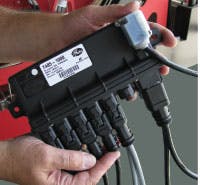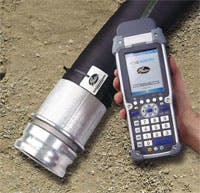Downtime at mines, construction sites, on wind turbines, drilling rigs, and in steel mills and manufacturing plants have one thing in common: it can be expensive. It’s especially problematic when hydraulic hose fails without warning. That poses a hazard to workers and surrounding machinery, not to mention the costs related to repair, cleanup, and lost production.
To improve uptime and productivity and lower operating costs, engineers at Gates Corp., Denver, Colo., developed a system that warns of impending hose failure. Called the Hose Diagnostic & Monitoring System, or HDMS, it lets equipment operators avoid breakdowns and keep hydraulic systems up and running. By estimating how close a hose is to the end of its life and, when appropriate, issuing a warning, HDMS alerts maintenance technicians to replace an assembly before it fails.
Previously, one of the only ways to gauge the health of a hose was by an imprecise visual check. “In essence, HDMS performs a daily inspection of the hose from the inside out and provides information that helps avoid catastrophic failures,” says Joe Skovrinski, a condition-monitoring engineer with Gates.
“Building diagnostic capabilities into our hose and performing predictive maintenance helps users better understand how equipment is actually being used and, thus, operate it more efficiently,” he adds.
HDMS is intended for high-value equipment, processes where unexpected downtime is costly, and where spills pose an environmental risk. Examples range from hydraulic safety valves on oil rigs to ag equipment, where farmers may have a narrow window to harvest crops. Hydraulic brake failure in a wind turbine can let the blades spin out of control and possibly self-destruct. And in mines, not only is lost production costly, oil spills demand cleanup and environmental remediation. “It’s lost money that will never be recovered,” says Skovrinski.
HDMS can help make equipment safer, reduce warranty costs, and let users build on existing diagnostics and predictive-maintenance programs.
For example, says Skovrinski, Liebherr Machine is using the device as a data logger rather than just for hose life prediction on its machines. “We also have a data logging capability you can invoke and watch almost in real-time pressure and temperature readings,” Skovrinski says.
HDMS basics
HDMS consists of a network of sensors, controller (ECU), and software that monitors hydraulic-system operations and gauges its effect on the hose. Four pressure-temperature transducers in the hydraulic circuits send data to the ECU. Pressure range is 0 to 8000 psig and temperature range is –40° to 250°F. It’s usually not the pressure, per se, but pulsations, the spike, and release of pressure that shorten hose life, explains Skovrinski. Gates defines a spike as a pressure surge of at least 133% of working pressure followed by a decrease of at least 50% from the peak value. Rapid pressure fluctuations are common in hydraulic circuits, so HDMS collects pressure data at a 50-Hz rate.
Temperature can also have a significant effect on hose life, says Skovrinski. Experience shows that temperatures within 20% of a hose’s upper or lower limits amplify the negative effects of pressure spikes on hose compounds. The temperature transducers take readings once per second.
Calculating life
Transducers transmit data via 4- to 20-mA signals to the ECU over wire lengths of up to 7 m. The ECU, developed by Gates and manufactured by sister company Schrader Electronics, Belfast, Northern Ireland, stores and crunches the data. The heart of its life-prediction software is an algorithm based on the SAE J1927 Standard. But years of test data and simulations have led Gates engineers to refine the calculations to better match actual results.
In essence, here is how it works. For hydraulic hose operating within specifications, at moderate temperatures, and with no pressure spikes that exceed the 133% point, life will diminish at a linear rate over time from 100% to failure at 0%. The Gates algorithm takes into consideration the detrimental effects of pressure spikes and temperature extremes on this baseline, and predicts a decrease in estimated hose life based on the cumulative impact of these factors.
How well does it predict hose failure? It’s accurate to within about ±10%, says Skovrinski. So by setting a limit, say at 20% of remaining estimated hose life available, HDMS will issue alerts as life approaches that 20% mark within ±10%. The OEM or user can specify at what point in the hose’s remaining life the warning is issued. For instance, the limit could be more conservative when failures cannot be tolerated.
The HDMS works with most types of Gates hydraulic hose, despite differences in reinforcement, temperature rating, and operating pressure range. “That’s significant because this algorithm works across our entire range. We’re not limited to a specific type of hose,” says Skovrinski.
It also warns of out-of-spec conditions, such as overpressures or excessive temperatures, as well as failure of sensors or the ECU. However, the device does not monitor for damage caused by abrasion, physical abuse, climate, or other external conditions.
The basic HDMS indicates fault conditions through an LED display. Technicians can connect a laptop PC to the ECU to download more detailed data. In the most-sophisticated version, the ECU connects to a GPS or cell-phone transmitter to automatically relay data and warning signals to a ground station, where data can be picked up by a remote PC, Internet, or telephone SMS. Updates are sent once every 24 hr via a cellular call or satellite link. Alarms, however, are sent every 5 min until acknowledged.
System setup
A menu-driven configuration program lets technicians specify parameters required by the cumulative-damage algorithm, such as number and types of hoses, their locations, and when before a failure to issue warnings.
Transducers are generally placed in the most heavily taxed circuits, such as lines subject to high-frequency cycling, shock and impact loads, and pressure extremes. Each transducer can monitor up to six different hoses in a single hydraulic circuit, provided all lines see similar pressure spikes and temperatures. The types and sizes of hose in the circuit are specified during setup, and the software applies appropriate damage algorithms to each.
It is built for mobile and stationary applications. Sensors are rated for ambient temperatures to 250° F and carry an IP-67 rating (for pressure wash downs). The ECU handles ambient temperature to 185° F and has an IP-65 rating (spillage and dust/dirt protection). Cabling uses Deutsch connectors, designed for harsh environments where dust, dirt, moisture, salt spray, and vibration can contaminate or damage electrical connections and equipment. It runs on 8- to 30-Vdc power.
Mobile-equipment manufacturers and dealers in the U.S. and Europe are evaluating HDMS for new designs and as an aftermarket option. It’s also being tested on stationary equipment. Skovrinski also says that, in response to the Gulf of Mexico oil spill, many in the offshore industry are evaluating the device for their equipment auditing processes.
For details, contact Joe Skovrinski at (303) 744-4143, or visit www.gates.com or www.schraderelectronics.com.
RFID for field identification
Predicting impending hose failure is critical in hydraulics, but it’s not the whole story when it comes to proactive maintenance. Technicians need to know details about replacement hose — type, size, length, and end fittings — to quickly repair and return equipment to service.
Identifying hose isn’t always easy. Hose might endure years of dirt, abrasion, and weathering that obscure external markings. Or it might be painted or mounted in an inaccessible location that makes the markings difficult to read.
Gates now uses RFID (radio-frequency-identification) tags on hose assemblies to speed and simplify identification. This gives operators and maintenance personnel instant access to hose-assembly information, letting them quickly make a new assembly or order replacement parts.
The tag attaches to the hose and stores information about the assembly. Gates technicians or fleet managers maintain a database that stores the tag’s identity and hose specs. Should an assembly require service, maintenance personnel scan the tag and call up information from the database. Operators can update and add hose information via the handheld device. Data in the PDA and main database are synchronized regularly.
According to Gates engineers, RFID offers advantages beyond speedy turnaround. A simple, comprehensive hose tracking and identification system lets suppliers monitor quality and inventory. RFID provides information that ties hoses being built to how they’re used, potentially permitting more-informed hose selection that results in even less downtime.




